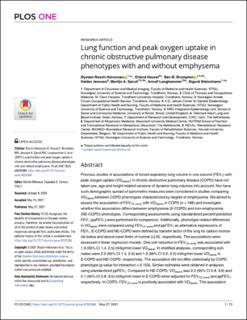| dc.description.abstract | Previous studies of associations of forced expiratory lung volume in one second (FEV1) with peak oxygen uptake (VO2peak) in chronic obstructive pulmonary disease (COPD) have not taken sex, age and height related variance of dynamic lung volumes into account. Nor have such demographic spread of spirometric measures been considered in studies comparing VO2peak between COPD phenotypes characterized by degree of emphysema. We aimed to assess the association of FEV1Z-score with VO2peak in COPD (n = 186) and investigate whether this association differs between emphysema (E-COPD) and non-emphysema (NE-COPD) phenotypes. Corresponding assessments using standardized percent predicted FEV1 (ppFEV1) were performed for comparison. Additionally, phenotype related differences in VO2peak were compared using FEV1Z-score and ppFEV1 as alternative expressions of FEV1. E-COPD and NE-COPD were defined by transfer factor of the lung for carbon monoxide below and above lower limits of normal (LLN), respectively. The associations were assessed in linear regression models. One unit reduction in FEV1Z-score was associated with 1.9 (95% CI 1.4, 2.5) ml/kg/min lower VO2peak. In stratified analyses, corresponding estimates were 2.2 (95% CI 1.4, 2.9) and 1.2 (95% CI 0.2, 2.2) ml/kg/min lower VO2peak in E-COPD and NE-COPD, respectively. The association did not differ statistically by COPD phenotype (p-value for interaction = 0.153). Similar estimates were obtained in analyses using standardized ppFEV1. Compared to NE-COPD, VO2peak was 2.2 (95% CI 0.8, 3.6) and 2.1 (95% CI 0.8, 3.5) ml/kg/min lower in E-COPD when adjusted for FEV1Z-score and ppFEV1, respectively. In COPD, FEV1Z-score is positively associated with VO2peak. This association was stronger in E-COPD but did not differ statistically by phenotype. Both the association of FEV1 with VO2peak and the difference in VO2peak comparing COPD phenotypes seems independent of sex, age and height related variance in FEV1. Mechanisms leading to reduction in FEV1 may contribute to lower VO2peak in E-COPD. | en_US |

